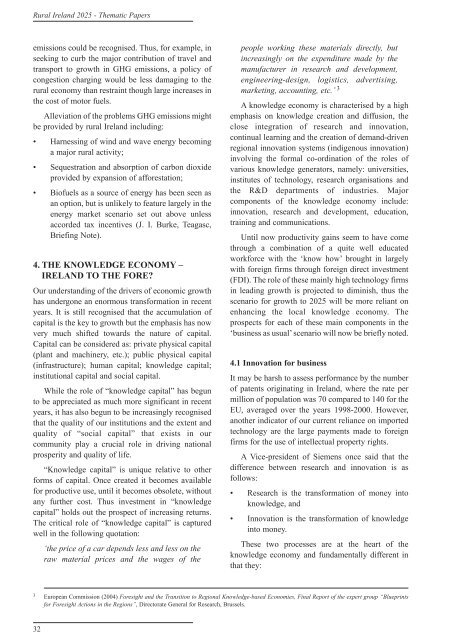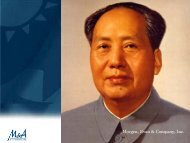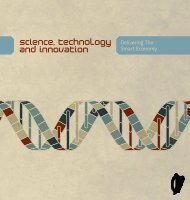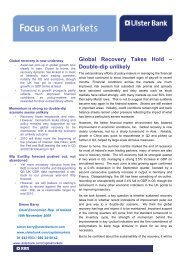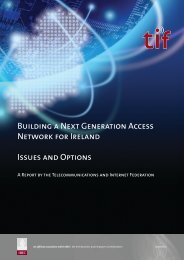RURAL IRELAND 2025 Foresight Perspectives - Coford
RURAL IRELAND 2025 Foresight Perspectives - Coford
RURAL IRELAND 2025 Foresight Perspectives - Coford
- No tags were found...
You also want an ePaper? Increase the reach of your titles
YUMPU automatically turns print PDFs into web optimized ePapers that Google loves.
Rural Ireland <strong>2025</strong> - Thematic Papersemissions could be recognised. Thus, for example, inseeking to curb the major contribution of travel andtransport to growth in GHG emissions, a policy ofcongestion charging would be less damaging to therural economy than restraint though large increases inthe cost of motor fuels.Alleviation of the problems GHG emissions mightbe provided by rural Ireland including:• Harnessing of wind and wave energy becominga major rural activity;• Sequestration and absorption of carbon dioxideprovided by expansion of afforestation;• Biofuels as a source of energy has been seen asan option, but is unlikely to feature largely in theenergy market scenario set out above unlessaccorded tax incentives (J. I. Burke, Teagasc,Briefing Note).4. THE KNOWLEDGE ECONOMY –<strong>IRELAND</strong> TO THE FORE?Our understanding of the drivers of economic growthhas undergone an enormous transformation in recentyears. It is still recognised that the accumulation ofcapital is the key to growth but the emphasis has nowvery much shifted towards the nature of capital.Capital can be considered as: private physical capital(plant and machinery, etc.); public physical capital(infrastructure); human capital; knowledge capital;institutional capital and social capital.While the role of “knowledge capital” has begunto be appreciated as much more significant in recentyears, it has also begun to be increasingly recognisedthat the quality of our institutions and the extent andquality of “social capital” that exists in ourcommunity play a crucial role in driving nationalprosperity and quality of life.“Knowledge capital” is unique relative to otherforms of capital. Once created it becomes availablefor productive use, until it becomes obsolete, withoutany further cost. Thus investment in “knowledgecapital” holds out the prospect of increasing returns.The critical role of “knowledge capital” is capturedwell in the following quotation:‘the price of a car depends less and less on theraw material prices and the wages of thepeople working these materials directly, butincreasingly on the expenditure made by themanufacturer in research and development,engineering-design, logistics, advertising,marketing, accounting, etc.’ 3A knowledge economy is characterised by a highemphasis on knowledge creation and diffusion, theclose integration of research and innovation,continual learning and the creation of demand-drivenregional innovation systems (indigenous innovation)involving the formal co-ordination of the roles ofvarious knowledge generators, namely: universities,institutes of technology, research organisations andthe R&D departments of industries. Majorcomponents of the knowledge economy include:innovation, research and development, education,training and communications.Until now productivity gains seem to have comethrough a combination of a quite well educatedworkforce with the ‘know how’ brought in largelywith foreign firms through foreign direct investment(FDI). The role of these mainly high technology firmsin leading growth is projected to diminish, thus thescenario for growth to <strong>2025</strong> will be more reliant onenhancing the local knowledge economy. Theprospects for each of these main components in the‘business as usual’ scenario will now be briefly noted.4.1 Innovation for businessIt may be harsh to assess performance by the numberof patents originating in Ireland, where the rate permillion of population was 70 compared to 140 for theEU, averaged over the years 1998-2000. However,another indicator of our current reliance on importedtechnology are the large payments made to foreignfirms for the use of intellectual property rights.AVice-president of Siemens once said that thedifference between research and innovation is asfollows:• Research is the transformation of money intoknowledge, and• Innovation is the transformation of knowledgeinto money.These two processes are at the heart of theknowledge economy and fundamentally different inthat they:3 European Commission (2004) <strong>Foresight</strong> and the Transition to Regional Knowledge-based Economies, Final Report of the expert group “Blueprintsfor <strong>Foresight</strong> Actions in the Regions”, Directorate General for Research, Brussels.32


